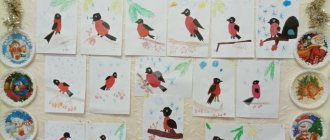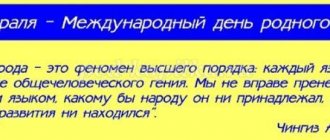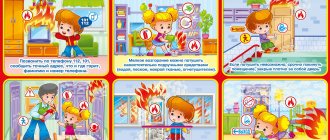Summary of educational activities for the development of self-service skills
Summary of educational activities for the development of self-service skills
Target:
Continue to teach children to independently care for their appearance and the condition of their clothing.
Tasks:
1. Strengthening children’s ability to put things back in their place
2. Formation of clothing care skills;
3. Formation of a desire for neatness; to the ability to notice and correct imperfections in appearance in oneself and other children;
4. Improving the ability to dress independently in the correct sequence;
5. Enrichment of vocabulary with the help of proverbs and sayings on the topic
Progress of the lesson
There's a knock on the door.
Educator:
Children, do you hear, someone came to visit us. Vika, let's go, open the door and meet the guest.
(An upset Luntik enters the group, introduces himself, begins to take off his outerwear and throws things around as he goes.)
Educator:
Hello! What happened, why are you so upset?
Luntik:
"Hello! My name is Luntik. My friends don't invite me to go out with them! So I'm upset. They say I'm sloppy, sloppy! Guys, tell me what these words are, what do they mean? I came to you for help, you know everything in kindergarten and can do everything!
Educator:
Luntik, we will help you! First, children, let's remember what these words mean - sloppy, sloppy?
(This is a person who does not keep his things orderly and clean and does not take care of his appearance.)
What did Luntik do wrong when he joined our group? (Scattered his things.) Let's tell you what you really need to do with them.
Children's individual answers:
- put the boots on the shoe rack,
- hang the jacket on a hook in the locker,
- Put the hat on the top shelf in the locker.
Educator:
And now Vanya and Polina will help me put Luntik’s things back in their places.
So that our advice is not forgotten, remember the proverbs and sayings about neatness that our children know.
Timur:
“The whole world is kept up by neatness”
Masha:
“Where there is neatness, there is neatness”
Seva:
“Whoever is neat is pleasant to people.”
Educator:
All things need to be looked after not only when they are old, but also when they are still new.
Luntik:
Oh, I still have a lot of things here! They're all mixed up and I don't know what to do with them! Teach me how to lay things out! (Pours things out of the bag.)
Several children help Luntik sort things into pairs, and neatly fold unpaired things or hang them on a chair.
Educator:
And our children also know that they need to not only carefully put things in their places, but also wear them carefully and take care of their appearance. Guys, let's look at our guest - what's wrong with his clothes?
(Children notice flaws in the doll’s clothes, and take turns going out to correct them)
- different socks,
- shoes on the wrong foot,
- shirt inside out.
Educator:
Remember one more lesson - “They are greeted by their clothes, but they are seen off by their minds” - this means that first of all people pay attention to the appearance of other people, their clothes, and only then to everything else.
Luntik:
Well done! Guys, you really know everything! You helped me a lot. But I want to see - do you know how to do all this yourself? I'll give you a test - who will dress correctly for a walk?
(The teacher selects 2 children who will show how they know how to dress. The test is carried out several times.)
Luntik:
Well done boys! Now I also know how to dress properly!
Educator
: So we helped Luntik! I hope now he won’t have any problems, and his friends will always invite him for a walk! Guys, let's remember what we taught our guest today? What proverbs and sayings does Luntik need to remember?
Luntik:
Thanks guys, you helped me a lot! I will remember your advice!
Open lesson with children of the middle group “Self-care skills”
Goal: Continue to teach children to independently care for their appearance and the condition of their clothing.
Tasks:
1. Strengthening children’s ability to put things back in their place
2. Formation of clothing care skills;
3. Formation of a desire for neatness; to the ability to notice and correct imperfections in appearance in oneself and other children;
4. Improving the ability to dress independently in the correct sequence;
5. Enrichment of vocabulary with the help of proverbs and sayings on the topic
Progress of the lesson
Educator: Children, this morning we received a letter, unsigned, no return address. Let’s read what is written there: “Hello! I need your help! I’ll come in the morning!”
Very interesting! (intercom ringing) And here, probably, is our guest!
(A doll enters the group, introduces itself, begins to take off its outerwear and scatters things as it goes.)
Doll: “Hello! My name is Katya doll. I'm upset. My girlfriends don't invite me to their place! They say I'm sloppy, sloppy! What kind of words are these, what do they mean? And what should I do now? You know everything here, so I decided to turn to you for help!
Educator: We know, Katya, how to help you! First of all, children, what do these words mean - sloppy, slob? (This is a person who does not take care of his things and his appearance.)
What did Katya do wrong when she entered? (She scattered her things.) Let's tell you what you really need to do with them.
Children's individual answers:
- put the boots under the bench,
- hang the jacket on a hanger,
- put the hat on the shelf.
the teacher helps put their outerwear back in its place. “So that our advice is not forgotten, remember the proverbs and sayings about neatness that our children know. Misha S. “Take care of the dress from new” (“means that all things need to be looked after not only when they are old, but also when they are still new”).
Doll: Oh, I still have a lot of things here! They're all mixed up and I don't know what to do with them! Teach me how to lay things out! (Pours things out of the bag.)
Children: Several children help the doll sort things into pairs, and neatly fold unpaired things or hang them on a chair.
Educator: “Things need to be put away, so you don’t have to look for them.” Children, you know that things need not only to be neatly put in their places, but also to be worn carefully and to take care of your appearance. Look at our guest - what's wrong with her outfit?
(Children notice flaws in the doll’s clothes, and take turns going out to correct them
- untied bow on the head,
- socks of different colors,
- slippers on the wrong foot,
- the blouse is not tucked in completely.)
Educator: Remember one more lesson - “They are greeted by their “clothes”, and seen off by their minds” (means that first of all people pay attention to the appearance of other people, to their “Clothes”, and only then to everything else).
Doll: Well done! Yes, you know a lot! You told me everything, and now I want to see - do you know how to do all this yourself? I'll give you a test - who will dress correctly for a walk?
(The teacher selects 2 children who will show how they know how to dress. And the rest come to the table, where cards with pictures of clothes are laid out, and show them in the correct sequence.)
Doll: Well done, guys! Now I also know how to dress properly!
Educator : So we helped the doll Katya! I hope she doesn't have any problems now! Let's remember what we taught our guest today? What proverbs and sayings does Katya need to remember?
Katya: Thank you guys, you helped me a lot! I will remember your advice!
Summary of a lesson on the formation of cultural and hygienic skills in an early age group
Lesson summary for the second early age group “Dasha washes her hands”
Goal: Formation of cultural and hygienic skills and habits. Objectives: • Teach correctly, name and show toilet items.
• Strengthen washing skills and the sequence of actions (roll up your sleeves, open the tap, wet your hands, then soap, rinse off the soap, shake the water from your hands, wipe dry with a towel). • Instill in children the need to wash their hands before eating and when dirty. • Develop self-service and independence skills. • Arouse interest in performing cultural and hygienic skills. • Cultivate a desire to perform the necessary washing procedure for health every day. • Enrich vocabulary, activate words denoting action in children’s speech. Didactic material: doll, personal hygiene items (soap, towel, toothbrush, toothpaste, soap dish, toothbrush case, cup, towel hook). Progress of the lesson
The teacher draws the children's attention to a doll with a dirty face and hands sitting in the corner. Educator: Guys, look, the doll Glasha came to visit us. Let's say hello to Glasha. Children in chorus: Good morning Dasha! Educator: Oh, guys, what’s wrong with our Dasha? Look carefully? (Children point out that the doll is dirty)
- How attentive you are to me!
Educator: Guys, the doll Dasha does not know how to wash herself and came to you for help so that you teach her to wash her hands and face and dry herself with a towel. Who wants to help our doll? (children's answers) Educator: What a great fellow you are for wanting to help the doll Dasha. Let's remember the sequence of hand washing, look at the picture. Looking at the illustration. Well done, you all remember! Guys, where do we wash our hands and wash ourselves? (Children's answers)
You're right, let's take Dasha with us and show us our toilet room.
(The teacher places the doll on chairs in the washroom.) Educator: Dasha, now our children will show you how to wash yourself properly. Guys, before you open the tap, tell me and show me what we do at the very beginning? Children: Roll up your sleeves! Educator: Correct. Let's roll up our sleeves so we can help each other. Who remembers why we do this? Children: So as not to get your clothes wet! Educator: You're right! And now I suggest you show our doll how to wash your hands. Do you agree? (children agree) Educator: Dasha, look at how our children first wet their hands with water, then take soap and lather until thick foam, so that they get white gloves, wash their hands in a circular motion. You should always wash your hands with soap. Show Dasha what soapy white gloves you have. Educator: Look, Dasha, how we wash off the soap with water without leaving a drop of soap on our hands. Now let's show the doll how we wash ourselves! (according to the teacher’s instructions, children wash their cheeks, chin, mouth, nose, eyes, forehead, naming parts of the face)
.
Saying the nursery rhyme “Water, water”: Water, water, Wash my face, So that my eyes shine, So that my cheeks blush, So that my mouth laughs, So that my teeth bite. Educator: Look, Dasha, our children know how to push their hands over the sink with their palms clasped. Show me how you do it! Now the children will find their towels and wipe their hands dry. (When drying his hands, the child finds and removes his towel from the hook, thoroughly wipes his hands, hangs it back on the hook. Lowering his sleeves. The teacher praises each child for proper soaping, squeezing, drying, etc.) Teacher: You see, Dasha, how our The children know how to wash and dry themselves. Let us wash you too. So that your hands and face become clean, and the guys will tell me what to do first. Do you agree? (The teacher washes the doll, the children suggest the sequence) (The teacher invites the children and the doll Dasha to go to the group) Educator: Guys, look, Dasha brought us a beautiful bag. Do you want to see what's in it? (children's answers)
.
We will take the items out of the bag one at a time, so it will be convenient for us. (Children take out washing supplies from the bag, tell them what they are for, name them) Educator: Guys, let’s find a home for each item? Didactic game “To each his own house” (You need to put all the accessories (soap, towel, toothbrush, toothpaste)
in their places, in their own houses
(soap dish, toothbrush case, cup, towel hook)
.
Educator: Guys, like us did you help the doll Dasha today? (children's statements)
The teacher speaks on behalf of the doll: You guys are great! Now I know how to wash my hands properly, and why they need to be washed with soap, and I also learned what washing supplies are and where they should be stored . I really liked it with you, and I want to stay with you.
Educator: Guys, what do you think of this? (statements from children)
. What else can you and I teach her?
(statements from children)
.
Educator: Well done guys, you all today we tried, we remembered how to wash our hands and wash ourselves properly. After all, it is very important to observe the rules of personal hygiene. You and I always wash our hands before eating, after using the toilet, and when dirty. - Now take the Dasha doll with you to play and teach her how to behave correctly in a group. Children take the doll and go play.
We recommend watching:
Joint activities in an early age group. Synopsis of a lesson with children in the first year of life Synopsis of a joint educational activity for children of the 1st junior group “Winter-Winter” Complex thematic lesson in an early age group together with mothers
Similar articles:
Lesson summary for an early age group. Cockerel
Lesson summary for an early age group. Dandelion
Summary of a game developmental lesson in an early age group on the topic: Rays of the sun
Game development activity in kindergarten for children of the third year of life
Lesson summary for the first early age group on the topic: Toys




